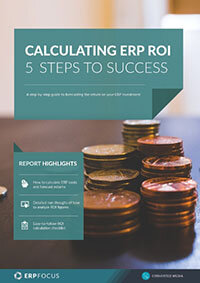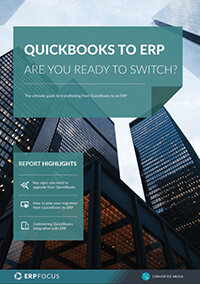Free white paper

ERP Implementation: 9 steps to success
The 9 proven steps you should follow when implementing ERP
Although it is very fashionable to write about ERP systems needing to be replaced every ten years or so, the selling of that notion to a business’s C-level is not nearly so fashionable. Clearly, there is a vested interest for software vendors to generate the perception of replacement need among customers; otherwise, growth becomes very difficult. But many of the arguments that convinced leadership to invest heavily in IT infrastructure – doing away with old, unconnected, band aided legacy systems written in COBOL; elevating security and financial controls to comply with financial auditing best practices; a consistent and consolidated look at business information across the enterprise – cannot be made when the issue is changing an ERP system. A worst case scenario is that your sales pitch is based on the replacement ERP platform simply doing more “stuff”.
Existing white papers seem to blur the lines somewhat as to whether a release version upgrade from your existing ERP vendor constitutes “ERP replacement”. It seems like a stretch to include this as a definition of replacement; systematic and routine upgrades were part of the original justification for ERP. The fact that religiously applying all of the patches, service packs, and small development releases is very difficult – in fact, it is often much easier to live with what you have than to have the discipline to continually test, fix, and install vendor updates – does not remove your original commitment to do so as part of your IT strategy.
Assuming, though, that you really do want to rip out your old ERP system and replace it with a different vendor’s package because you need different or additional functionality, what is available for financial payback that was not promised as part of your original conversion to ERP?
Unfortunately, one of the few avenues left to explore to financially justify replacing your ERP system is to move to Cloud ERP computing at replacement, essentially sacrificing your internal IT organization as a cost-reduction offering. The word “unfortunately” is used because many companies view IT as a cost center instead of a strategic asset (to that point, many companies do not have a strategy to utilize the rich business information of an ERP system). Trading away a strategic asset for marginally improved software is a poor exchange.
The bottom line is that if your ERP software does not have the functionality to handle your business competently ten years after an implementation, one of two things is true: (1) Your business model has changed so much that everyone in the organization – from the CEO to the shipping clerk – understands that the need for new software is inevitable, or (2) a fundamentally bad choice of ERP software was made ten years ago. If it is the latter case, it may be better for the organization to be brutally self honest - with the benefit of hindsight - rather than try to create the illusion of a financial justification.

The 9 proven steps you should follow when implementing ERP


Get the latest pricing information on over 80 popular ERP systems, and learn how to budget for your ERP project in our free guide
Download
Calculate your new ERP's financial benefits with this comprehensive guide
Download
Get the definitive guide to converting your business from Quickbooks to ERP
Download![Three direct links between ERP and manufacturing revenue [image by Snowing on Freepik] Three direct links between ERP and manufacturing revenue [image by Snowing on Freepik]](/pictures/W1siZiIsIjIwMjUvMDEvMjAva2ZwYjAzb3gzX1RocmVlX2RpcmVjdF9saW5rc19iZXR3ZWVuX0VSUF9hbmRfbWFudWZhY3R1cmluZ19yZXZlbnVlX2ltYWdlX2J5X1Nub3dpbmdfb25fRnJlZXBpa18uanBnIl0sWyJwIiwidGh1bWIiLCI0MDB4MjY2IyJdLFsicCIsImVuY29kZSIsImpwZyIsIi1xdWFsaXR5IDg1Il1d/Three%20direct%20links%20between%20ERP%20and%20manufacturing%20revenue%20%5Bimage%20by%20Snowing%20on%20Freepik%5D.jpg?sha=b45b02a140cc8680)
What you need to know to help you achieve a return on your manufacturing ERP investment

Learn how Godlan ensures successful ERP implementation for manufacturers with proven strategies &...
![3 Tips for Achieving Buy-In for Your ERP Integration [by pressfoto on Freepik] 3 Tips for Achieving Buy-In for Your ERP Integration [by pressfoto on Freepik]](/pictures/W1siZiIsIjIwMjQvMTAvMjkvNnQyNmRwdzdwYl8zX1RpcHNfZm9yX0FjaGlldmluZ19CdXlfSW5fZm9yX1lvdXJfRVJQX0ludGVncmF0aW9uX2J5X3ByZXNzZm90b19vbl9GcmVlcGlrXy5qcGciXSxbInAiLCJ0aHVtYiIsIjQwMHgyNjYjIl0sWyJwIiwiZW5jb2RlIiwianBnIiwiLXF1YWxpdHkgODUiXV0/3%20Tips%20for%20Achieving%20Buy-In%20for%20Your%20ERP%20Integration%20%5Bby%20pressfoto%20on%20Freepik%5D.jpg?sha=0e1a55a6cfcac344)
Read our expert’s tips on getting your ERP integration project off the ground by achieving busine...